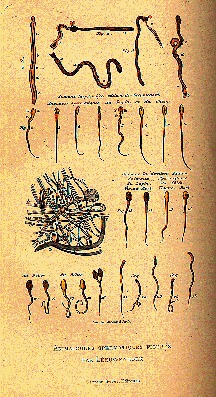18TH C ACCOUNTS OF ANIMAL DEVELOPMENT
THE DIFFERENT POSITIONS
(A) PREFORMATIONISM
 |
| Buffon's "Animalcules spermatiques figurés par Léeuwenhoek" Courtesy University of Pennsylvania where there is further introductory material on 18th Century study of animals |
The embryo was a set of particles already organized into the structure of the adult. Development is the unfolding of a form that is already, in collapsed form, there. Two varieties:
(i) structure of the embryo formed by the parent Maupertuis (1745) held that "organic particles" derived from either parent lock into configuration to form the embryo, which then develops through simple expansion.
(ii) structure of the embryo formed by God at creation (the emboitment principle of Bonnet).
(B) EPIGENICISM
The embryo was a set of particles in disorder, which gradually in time take on the order of the adult.
Caspar Wolff defended an epigenicist view. He held that the force responsible for introducing the order was a "vital force".
THE DIFFERENT TYPES OF FORCES
You can ask in each case what was thought to be responsible for the order possessed by the adult form. The answer in each case is a force or forces . What forces were recognized in the 18th C ?
IMPACT
The force of impact was the paradigm. Bump into a particle and it will move off in a determinate direction and with a determinate velocity.
Early mechanists tried to explain how everything could be explained in terms of this force, acting on simple small hard particles. (See e.g. Allen G. Debus, Man & Nature in the Renaissance Cambridge, 1978, CUP, p.107)
GRAVITY, MAGNETISM, ELECTRICITY
Newton famously postulated another force, the force of gravity.
He also recognized magnetic and electrical force.
Wolf, the epigenicist, invoked a new force again, needed he thought to explain how embryonic confusion of particles got organized: a vital force.
Gravity, the magnetic force and the electrical force (and the vital force) were conceived of as acting at a distance, contrasting with the force of impact.
The problem was to explain the origin of the adult organization, obviously complicated, in terms of these forces acting in the context of a very much smaller and apparently very much simpler embryo.
A MULTIPLICITY OF DISTANCE-ACTING FORCES
Maupertuis held that each specific part of the body manufactured a specific particle to contribute to the semen (held to come from either parent) and thus to become part of the embryo. Each particle exerted a distinctive force, which served to orient it distinctively towards each of the others. It was the action of these forces on the particles which pulled them into the organization which constituted the embryo (which once formed simply expanded).
So Maupertuis was involved in postulating a myriad of distinctive forces, all acting at a distance (and thus, as it is confusingly said, "non-Newtonian"). In the end he himself found this unsatisfactory.
Buffon's alternative was to hold that the organization could be done through the action of Newtonian forces alone. Clearly he failed to convince all his contemporaries.
THE VITAL FORCE
Wolff's approach took a middle course between the pure Newtonianism of Buffon and the profligacy of Maupertuis and his multiplicity of non-Newtonian forces: he invoked a new vital force, acting at a distance on organic particles to pull them into order.
ALTERNATIVE CONCEPTIONS OF DEVELOPMENT
Is there an alternative to this conception of development as a kind of marshalling of particles?
The conception that took shape (and eventually over) at the turn of the Century was this: the embryo considered as a whole has intrinsic to it a plan of the adult form and an initiative which in appropriate conditions drives towards the fulfilment of the plan. You find this in Goethe.